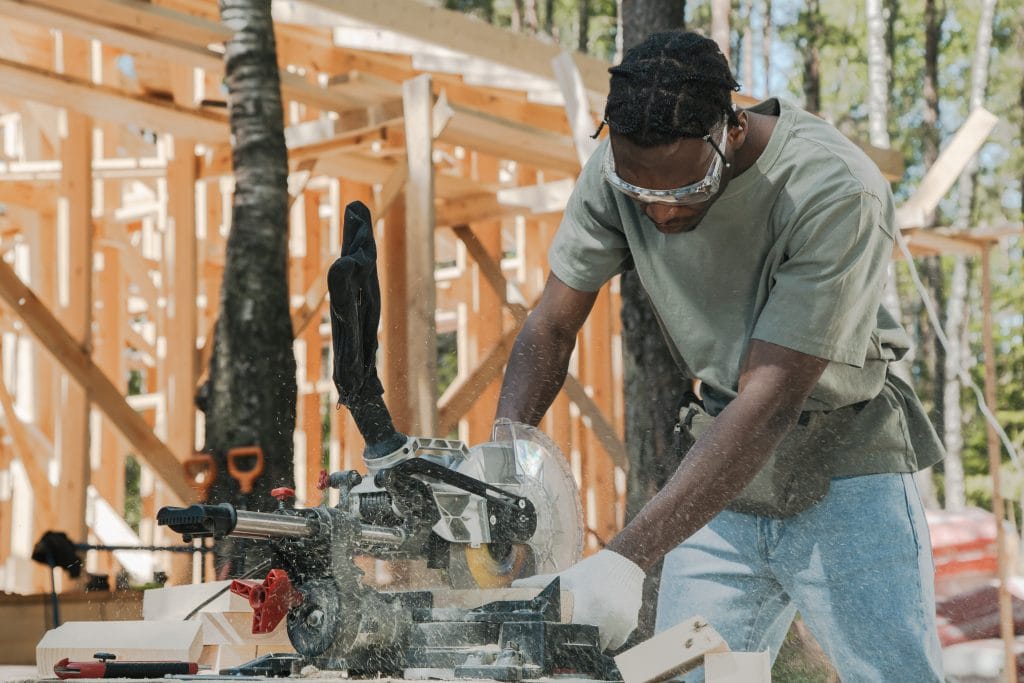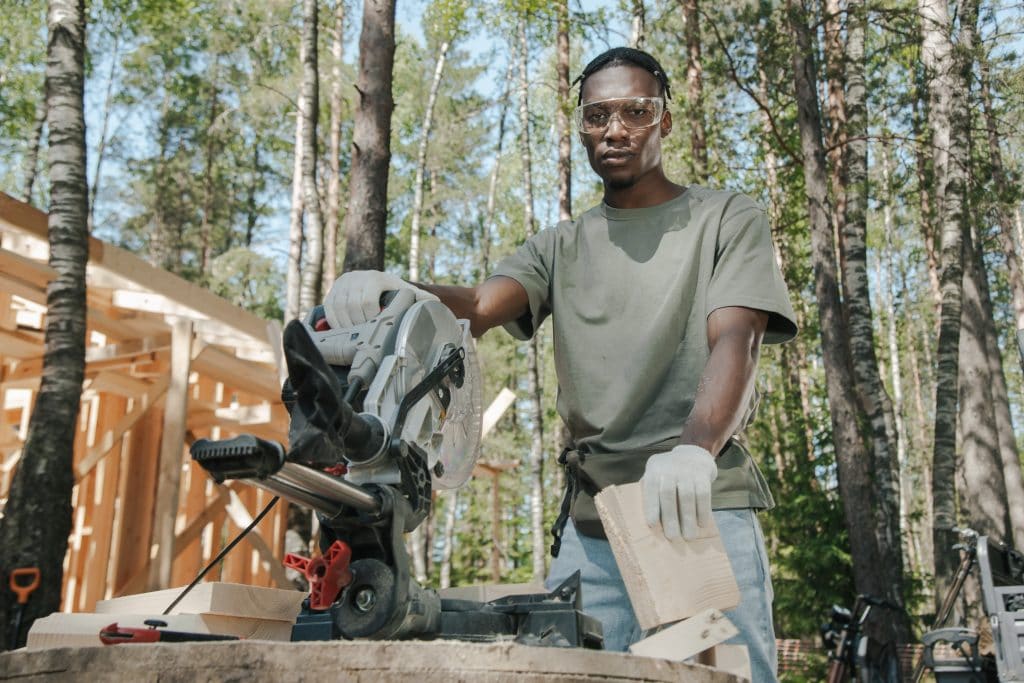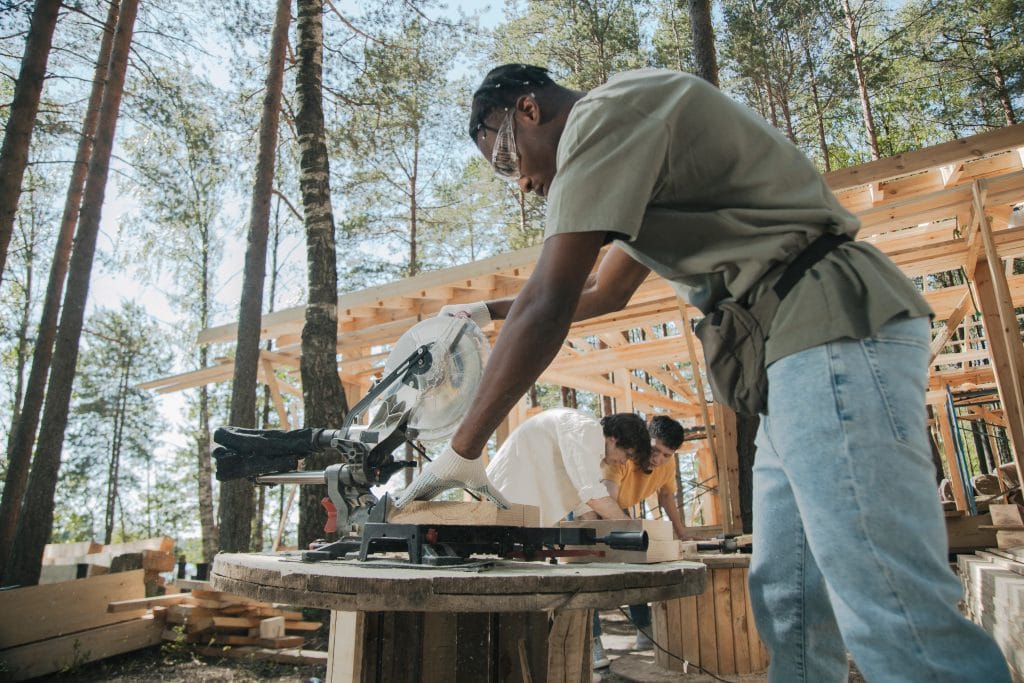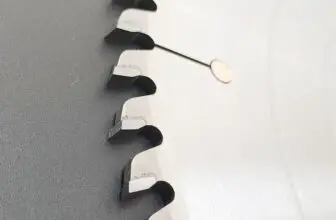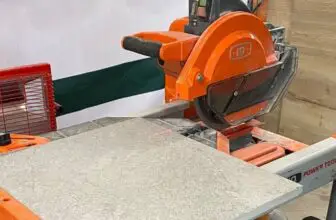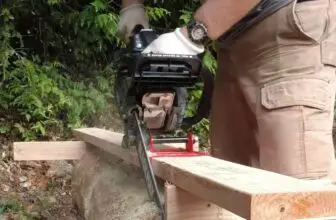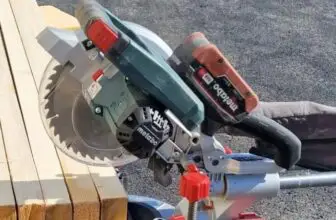
Every person connected with the building industry at some point faces the problem of choosing and buying a miter saw for particular tasks. Miter saws are mainly used for making clean cuts in lumber, plastic, or aluminum and cutting large pieces of material into smaller ones. A large list of options is available with this instrument. For example, builders use it for installing linings, moldings, and even parquets and plinths.
Nowadays numerous types of miter saws with different functionality are presented on the market. It’s pretty challenging to choose the right one for a person without any experience in the sphere, so I’m here to help you. In this article, I’ll determine the main features of every miter saw type and compare their characteristics in several situations. Let’s get started.
Guide on Major Types, Pros & Cons of Miter Saws
Contents
Besides the primary standard model of a miter saw, a bunch of modernized and improved variations exist for the satisfaction of building needs. Here is the list:
- standard miter saw;
- sliding miter saw;
- compound miter saw;
- compound sliding miter saw;
- dual compound sliding miter saw.
I’ll define the main miter saw differences and sum up all the pros and cons.
Standard miter saw
It’s a basic model without any additional functions or instruments like sliders or lasers. It’s the cheapest option suitable for home usage. The whole construction consists of 5 main parts:
- electric engine;
- shaft and circular blade;
- handle and saw head;
- base.
Every miter saw has these major components. Cordless models with Li-ion batteries are also presented on the market.
The following technical characteristics depend on the saw model:
- power;
- width of cut;
- height of cut;
- blade rotation speed;
- cutting angle;
- cutting capacity.
Let’s take a closer look at these parameters.
Power
Commonly, standard miter saws have low-average power (1000W-1800W) because they are targeted at a wide range of customers, so usually, there is no need for setting up high numbers. More powerful devices are often chosen by professional carpenters who work with numerous difficult tasks like cutting hardwood species or aluminum.
Width and height of cut
Cut width is not the main advantage of standard saws. It doesn’t have any type of slide mechanism, so the cut width, as well as cut height, depends only on the blade size. Professionals prefer to buy saws with large blades (12” – 20”), but a 9-12-inch blade size is considered to be sufficient by the majority of amateurs. I recommend avoiding buying very small blades (<7”), as they can limit your possibilities in cutting.
Blade rotation speed
Blade rotation speed has to be selected taking into account the material characteristics like hardness or viscosity and the blade’s max rotation speed. The wrongly chosen speed can lead to the blade, material, or even saw being damaged. The Max blade speed of all miter saws usually ranges between 4000 – 5000 r/m, but some professional models can accelerate a shaft up to 8000 r/m. However, bear in mind that the normal working speed for miter saws is 3000 – 3500 r/m, and constant pushing to the limit can lead to engine failure and safety issues.
Cutting angle
In most devices accessible to regular people, the cutting angle does not exceed 45 degrees on only one side (typically left). That is because the large engine limits the handle’s movements. However, some expensive models can cut at a 50-60-degree angle.
Should you buy a standard non-sliding miter saw or is it better to take something more advanced? If you don’t need to cut large pieces of wood in huge volumes, that is the right choice. The standard specification has a pretty affordable price and is perfectly suitable for home usage.
- low price;
- lightweight;
- suitable for home use.
- non-sliding;
- short cut width;
- no additional features.
Sliding miter saw
This saw type doesn’t have very impactful distinctive features except one – you can pull the blade not only downward but forward and backward too. In other words, here you can cut not only vertically but horizontally.
The main benefit of the construction is a significantly increased width of the cut. On average, the sliding mechanism increases cutting width from normal 2.5” – 6.5” (depending on blade size) to 10” – 14”.
Such saws are more expensive than standard ones, but even amateur carpenters frequently prefer sliding miter saws to standard ones. It’s better to buy this type of saw if you have to deal with large and wide pieces of wood or plastic. It can also be used for home purposes. However, it costs a bit more than the standard specification.
- affordable price;
- suitable for home usage;
- a slider (cut width is prolonged).
- no additional features.
Compound miter saw
What is a compound miter saw? This type combines a miter and circular saw into one solid mechanism. It’s still the same standard miter saw but with a special “table” placed a bit lower than the top of the blade. When the handle is put down, you can use this “table” with a blade as a common circular saw.
The benefits of the structure are evident – you get more flexibility in making workpieces. Moreover, the circular saw feature allows you to get a smoother surface after cutting. It’s pretty handy and lightweight, and the difference in weight with other miter saws is minimal. The price of compound saws is higher than the cost of other models, but buying circular and miter saws as two different devices are more expensive.
The max disk size is typically smaller on these types of saws. Also, there is no sliding mechanism, so you might have some problems with large pieces. Don’t forget that you’ll have to choose one blade suitable for both working modes.
Overall, it’s a good choice for people who want to save money on buying a two-in-one device instead of purchasing two different ones. Remember, there is no slider, so the cut width is limited.
- two-in-one device;
- still cheaper than buying 2 different instruments;
- convenient to use.
- heavy;
- the disk is typically smaller;
- no slider.
Compound sliding miter saw
The previous model on the list has one big disadvantage, which is the absence of a sliding mechanism. Here is the solution. Compound sliding miter saws include a slider, which makes these models much more appealing to professional carpenters.
In addition to the circular saw feature, it has all slider benefits, so compound sliding saws are pretty demand not only among professionals. Because of the slider, the price for this model is slightly higher than on a regular compound one.
- two-in-one device;
- cheaper than buying 2 different tools;
- convenient to use;
- a slider.
- heavy;
- the disk is typically smaller.
Dual compound sliding miter saw
All non-dual miter saw types have a disadvantage that might be fatal in some specific situations: the saw handle leans only to the left or, rarely, to the right. The saw engine is an obstacle to free rotation, so the engineers have replaced it. In these models, rotating is available on both sides, and this is a two-in-one saw with a slider.
All these excesses cost money, so dual miter saws are much more expensive and required only for a tight range of tasks. It’s a timesaver; in some cases, you don’t need to shift your material, just rotate the saw to the opposite side.
That is the choice of a professional who knows his job. I don’t recommend buying this tool for home usage. It might be a waste of money because you most likely won’t use all the features provided by the saw.
- two-in-one device;
- extremely convenient to use;
- a slider;
- 90-degree cutting range.
- heavy;
- pretty expensive miter saw type;
- the disk is usually smaller.
Which size to buy?
It’s an obvious question many users face when buying a blade and saw suitable for particular purposes. First, it’s always better to buy a saw with a wider max blade diameter. With a big disk, you’ll get:
- high cutting speed;
- better control;
- bigger cutting width and height;
- an ability to cut hardwood species and metal easily;
- big and heavy saw.
However, there are a bunch of disadvantages coming with bigger saws:
- higher price;
- they are hard to use when cutting out small details;
- big disks can tear down softwood and plastic in some cases.
Everything depends on your purposes. If your work is to do small cuts on softwood, it might be better to take smaller blades (<7” in diameter). If you need the instrument to complete a repair or for a home workshop, I recommend buying a medium-sized disk (8” –14”). However, if you are dealing with hard materials and metal, you should take a large device (>14”). Bear in mind that not only the blade size affects your cuts; choosing the right disk is another deal.
Slide vs glide miter saws
The glider mechanism is an innovation in the sphere. The solution doesn’t have rails on the backside of the saw, which means more free space. However, some buyers complain about faults in the mechanism assembly, which can lead to inaccurate cuts. Glide saws are now manufactured only by a single company, Bosh. In general, it’s a pretty accurate, handy, and good-looking alternative to the traditional rail system.
Corded vs cordless miter saws
Corded devices are mostly cheaper and usually installed in stationary workshops. They can be heavy but are more powerful and accurate. The bigger blades are commonly used with this saw type.
In contrast, cordless systems are more expensive and designed for mobile usage. The main advantage is that you can bring this tool wherever you want with no problems because it’s lightweight and compact. However, cordless miter saws are limited in energy usage, so they’re less powerful and, sometimes, a bit less accurate.
Despite all the facts, there are a lot of modern high-quality cordless models on the market that are not inferior to the quality of the corded ones. The only question is the price.
FAQ About Types of Miter Saws
Here are some frequently asked questions that can be useful to you.
What is the difference between single- and double-bevel miter saws?
A single-bevel saw can be turned only to the left or to the right side because of a massive engine block. In double-bevel miter saws, the engine is placed on the backside of the saw head, so it can be easily rotated on both sides.
It’s much easier to work with double-bevel saws because you don’t need to shift a wood piece every time you change the direction of the cut. Just rotate the saw head instead.
What is the difference between a miter and a bevel?
A miter is a cut made with a blade set vertically at any angle except 90°. In contrast, while making a bevel cut, a disk has to be turned at any angle except 90° to the surface. Also, a fully straight cut is called straightforward.
What is the most versatile miter saw?
The dual-laser compound sliding miter saw is the most versatile saw type on the current market. It has a lot of useful features like laser adjusting, 90-degree rotation, a sliding mechanism, and the function of a circular saw. However, these kinds of saws can’t be cheap and are mainly used by professionals.
Which transmission type is better: geared or belt?
There are two ways the saw engine can run the shaft – with the belt or with gears. The geared systems are usually installed on more expensive saws because of a bunch of advantages: faster acceleration, higher max speed, and better control. Belt engines are also pretty good and widely used, but it’s a pleasure to cut with a geared saw.
Choose the Right Miter Saw for Your Needs
Overall, a standard non-sliding miter saw with a 7” – 10” blade diameter is a cheap solution for working with small details. Saws with sliding mechanisms are suitable for processing large pieces of wood. Compound saws are a handy two-in-one option for any person. Dual miter saws will make your work more efficient and comfortable.
So, the choice is yours. Determine your purposes, and the decision will turn out to be evident. What miter saw do you use? Are you satisfied with its functionality? Share your opinion in the comments below and discuss it with other users.


